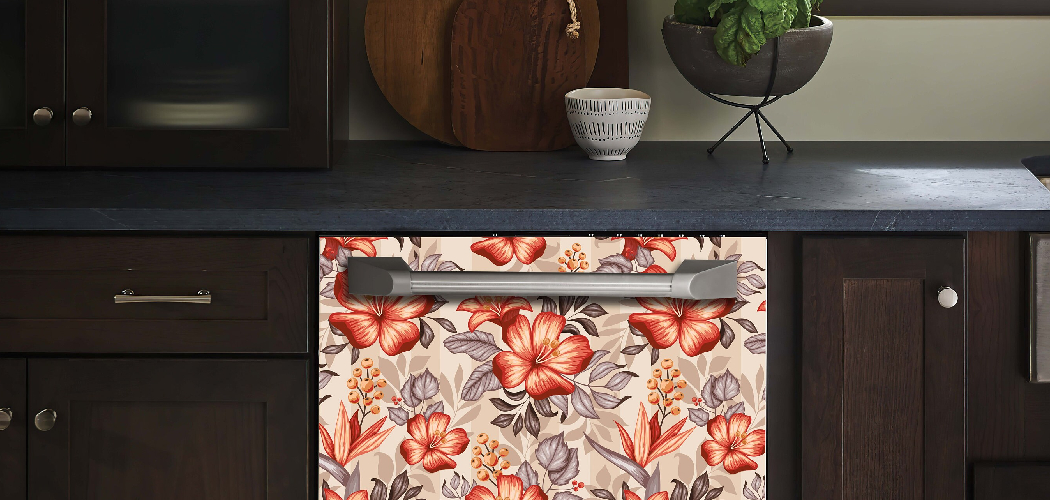Painted furniture can add a vibrant touch to any room, infusing color and personality into your living space. However, maintaining the beauty and durability of painted surfaces requires some special care.
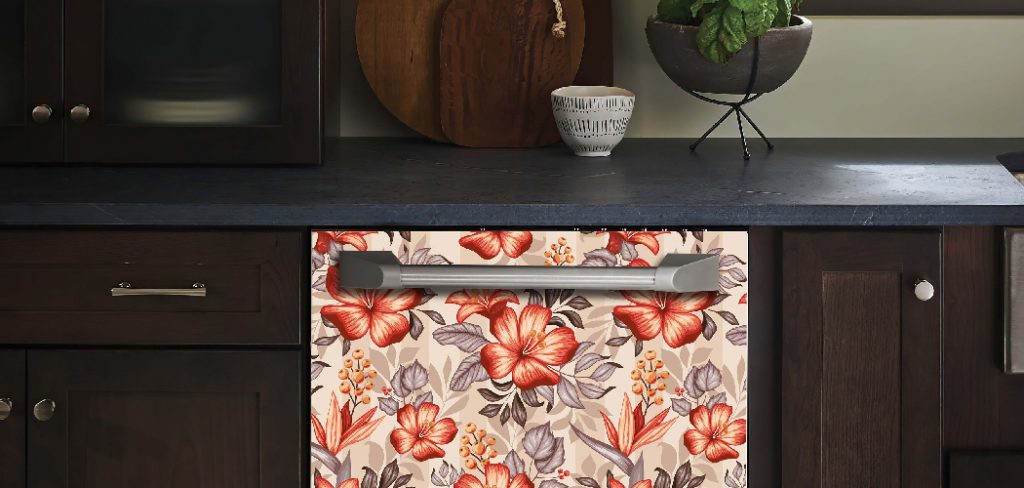
Protecting painted furniture involves a combination of regular cleaning, proper handling, and preventive measures to guard against common issues such as chipping, fading, and scratches. This guide on how to protect painted furniture will provide you with practical tips and techniques to keep your painted furniture looking pristine for years to come.
Why is it Important to Protect Painted Furniture?
Painted furniture experiences a lot of wear and tear, whether it’s from daily use or exposure to elements such as sunlight, moisture, and heat. Without proper protection, painted surfaces can quickly become damaged and lose their original luster.
Furthermore, paint can be a costly and time-consuming investment, so it’s essential to protect your furniture to prolong its lifespan. With the right techniques, you can maintain the color and finish of your painted furniture for longer and avoid the need for frequent touch-ups or refinishing.
Needed Materials
Soft, Non-abrasive Cloths or Sponges:
When cleaning painted furniture, it’s crucial to use soft and non-abrasive materials to avoid scratching the surface. Microfiber cloths or sponges are ideal for gentle and effective cleaning without causing any damage.
Mild Detergent:
Avoid using harsh chemicals or abrasive cleaners on painted surfaces as they can strip away the paint or cause discoloration. Instead, opt for a mild detergent mixed with warm water for regular cleaning.
Furniture Wax:
Waxing is an excellent way to protect painted furniture from scratches and moisture while also adding a layer of shine. Choose a furniture wax specifically meant for painted surfaces, such as beeswax or paste wax.
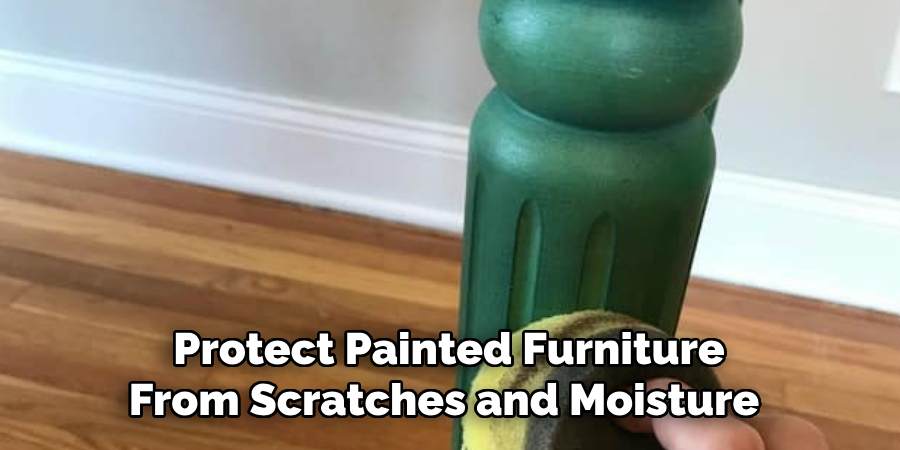
Varnish or Topcoat:
For added protection against chipping and fading, consider applying a varnish or topcoat. These products create a hard and durable layer over the paint, providing extra protection from daily use and external factors.
8 Easy Step-by-step Guidelines on How to Protect Painted Furniture
Step 1: Dust Regularly
Dust can accumulate on painted furniture, leading to a dull appearance and potential abrasion that can wear down the paint over time. To protect your painted furniture, make it a habit to dust regularly using a soft, non-abrasive cloth or a microfiber duster. These materials effectively remove dust without scratching the painted surface.
Dusting at least once a week is recommended, especially for furniture in high-traffic areas or rooms prone to dust buildup. This simple yet essential step helps maintain the vibrant appearance of your painted furniture and extends its longevity.
Step 2: Clean with a Mild Detergent
In addition to dusting, it’s essential to give your painted furniture a deeper clean every once in a while. For this, mix a small amount of mild detergent with warm water and use a soft cloth or sponge to gently wipe down the surface. Avoid using too much water or allowing excess moisture to sit on the paint for an extended period as this can cause damage.
After cleaning, make sure to dry the surface thoroughly with a clean cloth to prevent any potential water damage. This step removes any buildup of dirt and grime that can lead to discoloration or chipping if left unattended.
Step 3: Apply Furniture Wax
After cleaning, consider applying furniture wax to add an extra layer of protection and shine. Using a soft cloth, gently rub the wax onto the painted surface in a circular motion. Allow the wax to sit for a few minutes before buffing it off with another clean cloth.
Furniture wax helps protect against moisture, scratches, and fading while also enhancing the appearance of painted furniture. This step is especially useful for high-touch areas such as tabletops or chair arms.
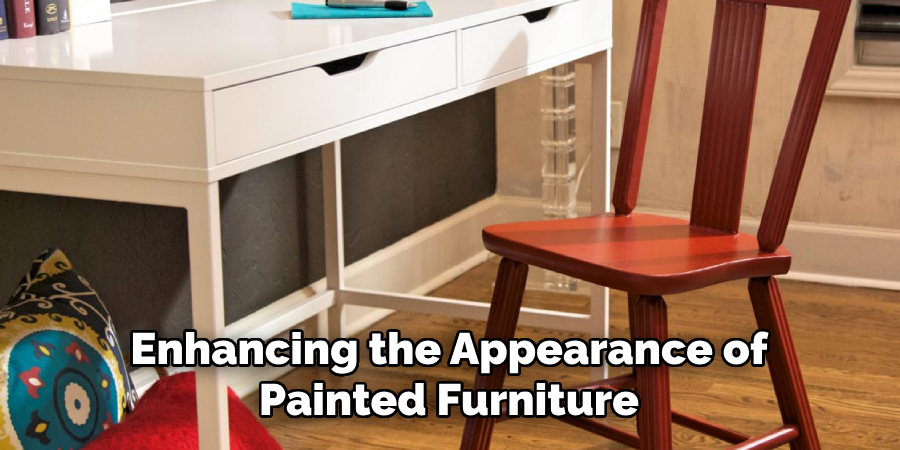
Step 4: Use Coasters and Mats
To prevent damage from spills, heat, or moisture, make sure to use coasters and mats on your painted furniture. This simple preventive measure can go a long way in protecting your furniture from potential stains or water damage.
Place coasters under glasses and cups to prevent water rings and use mats under hot dishes or pots to avoid heat damage. These small but effective actions can help preserve the beauty and durability of your painted furniture.
Step 5: Avoid Direct Sunlight
Exposure to sunlight can cause fading and discoloration on painted surfaces over time. It’s essential to keep your painted furniture away from direct sunlight, especially if it’s placed near windows or in rooms with lots of natural light.
If moving the furniture is not an option, consider using window treatments such as curtains or blinds to block out UV rays. This step helps protect against fading and keeps your painted furniture looking vibrant for longer.
Step 6: Handle with Care
Proper handling is crucial in maintaining the integrity of painted furniture. When moving or rearranging your furniture, always lift rather than drag it across the floor. Dragging can result in scuffs, scratches, and even chipping of the painted surface. It’s also advisable to use furniture pads or sliders to prevent any accidental damage during relocation.
Additionally, be mindful of how you use the furniture daily. Avoid placing heavy or sharp objects directly on the painted surfaces, and refrain from using the furniture for purposes it wasn’t designed for, such as standing on chairs or tables. By handling your painted furniture with care, you can significantly reduce the risk of surface damage and ensure its longevity and pristine appearance.
Step 7: Touch Up as Needed
Despite your best efforts to protect painted furniture, accidents can happen, and chips or scratches may occur. In such cases, make sure to address them promptly by touching up the affected area with matching paint.
Keep a small container of touch-up paint on hand for quick fixes, and make sure to properly blend the new paint with the existing one for seamless results.
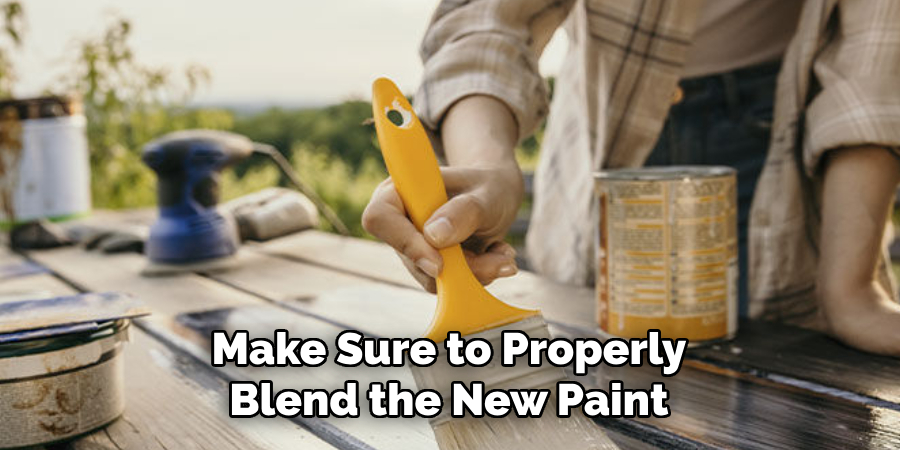
Step 8: Reapply Varnish or Topcoat
Over time, the protective layer of varnish or topcoat on painted furniture may wear off, leaving the surface vulnerable to damage. To maintain optimum protection, consider reapplying a varnish or topcoat every few years or as needed.
Before reapplication, make sure to properly clean and prepare the surface by removing any dust or buildup. Follow the product instructions for application and allow sufficient drying time before using the furniture again.
Following these easy step-by-step guidelines on how to protect painted furniture can help protect your painted furniture and keep it looking beautiful for years to come. By incorporating regular cleaning and maintenance into your routine, you can ensure that your furniture remains a statement piece in your home for a long time. Remember to handle with care and address any damages promptly for the best results.
Additional Tips
Use Protective Covers
For painted outdoor furniture, consider using protective covers when the furniture is not in use. Covers can shield against weather elements such as rain, snow, and UV rays, which can all cause damage over time. Excellent to use during off-seasons, they help to prolong the life and vibrant appearance of your painted furniture.
Maintain a Consistent Environment
Fluctuating temperatures and humidity levels can cause wood to expand and contract, potentially leading to cracks in the paint. To avoid this, try to maintain a consistent environment within your home. Using a humidifier or dehumidifier as needed can greatly help in preserving both the wood and the paint on your furniture.
Limit Chemical Exposure
Certain chemicals can adversely affect the paint on your furniture. When using cleaning products around your painted pieces, make sure they are safe for painted surfaces. Avoid placing painted furniture near areas where harsh chemicals or cleaning solvents are frequently used to prevent accidental damage.
Use Felt Pads
Attaching felt pads to the bottom of objects like vases, lamps, or picture frames can prevent scratches and scuffs on painted surfaces. Take an extra step by also placing felt pads under the legs of chairs and tables to protect both the painted furniture and your floors from potential damage.
Educate Family Members
Make sure everyone in your household is aware of the steps to take to protect painted furniture. Educating family members, especially children, about not placing dirty or wet objects on the furniture and avoiding rough play around it can significantly help in maintaining its pristine condition.
By following these additional tips along with the step-by-step guidelines, your painted furniture can remain a beautiful and functional part of your home for many years to come.
Frequently Asked Questions
Q: Can I Use Regular Cleaning Products on Painted Furniture?
A: It’s best to avoid using harsh chemicals or solvents on painted surfaces as they can damage the paint. Instead, opt for gentle and safe cleaning solutions specifically designed for painted furniture. It’s always a good idea to test products in an inconspicuous area before using them on the entire piece.
Q: Is It Necessary to Reapply Varnish or Topcoat on Painted Furniture?
A: While it’s not necessary, reapplying a varnish or topcoat every few years can help maintain the protective layer on your painted furniture. This is especially important for outdoor furniture that is exposed to weather elements.
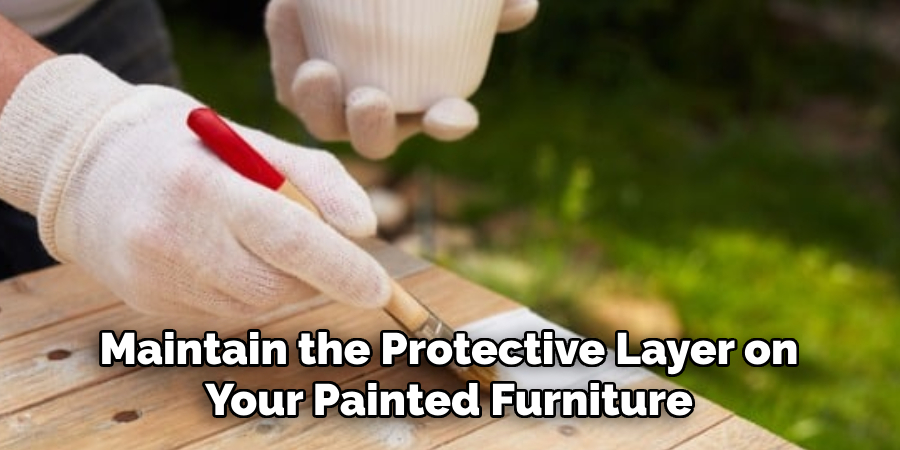
Q: Can I Touch Up Chips and Scratches on My Own?
A: Yes, minor chips and scratches can be touched up with matching paint. Make sure to properly prepare the surface and blend in the new paint for best results. For major damages, it’s best to seek professional help for repairs.
Conclusion
By diligently following the steps and tips outlined in this guide on how to protect painted furniture, you can ensure that your painted furniture remains in excellent condition for years to come. Regular maintenance, careful handling, and prompt attention to any damage will preserve the beauty and functionality of your beloved pieces.
Whether your furniture is a vintage heirloom or a newly painted project, the effort you put into its care will be well worth it. Your painted furniture can continue to enhance the aesthetic of your home while serving as a testament to your dedication to preservation and detail.
